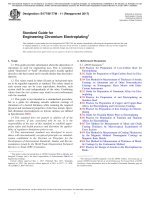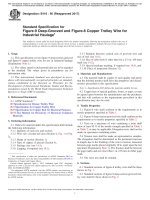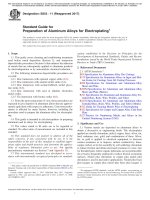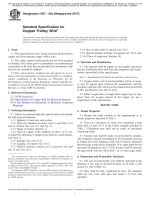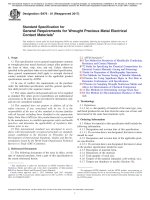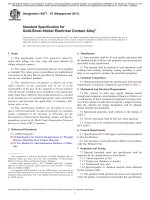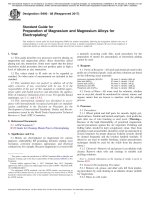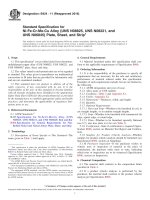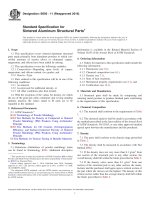Astm b 253 11 (2017)
Bạn đang xem bản rút gọn của tài liệu. Xem và tải ngay bản đầy đủ của tài liệu tại đây (120.34 KB, 7 trang )
This international standard was developed in accordance with internationally recognized principles on standardization established in the Decision on Principles for the
Development of International Standards, Guides and Recommendations issued by the World Trade Organization Technical Barriers to Trade (TBT) Committee.
Designation: B253 − 11 (Reapproved 2017)
Standard Guide for
Preparation of Aluminum Alloys for Electroplating1
This standard is issued under the fixed designation B253; the number immediately following the designation indicates the year of
original adoption or, in the case of revision, the year of last revision. A number in parentheses indicates the year of last reapproval. A
superscript epsilon (´) indicates an editorial change since the last revision or reapproval.
This standard has been approved for use by agencies of the U.S. Department of Defense.
ization established in the Decision on Principles for the
Development of International Standards, Guides and Recommendations issued by the World Trade Organization Technical
Barriers to Trade (TBT) Committee.
1. Scope
1.1 This guide covers cleaning and conditioning treatments
used before metal deposition (Section 5), and immersion
deposit/strike procedures (Section 6) that enhance the adhesion
of metals that are subsequently applied to aluminum products
by electrodeposition or by autocatalytic chemical reduction.
2. Referenced Documents
2.1 ASTM Standards:2
B85 Specification for Aluminum-Alloy Die Castings
B179 Specification for Aluminum Alloys in Ingot and Molten Forms for Castings from All Casting Processes
B209 Specification for Aluminum and Aluminum-Alloy
Sheet and Plate
B209M Specification for Aluminum and Aluminum-Alloy
Sheet and Plate (Metric)
B221 Specification for Aluminum and Aluminum-Alloy Extruded Bars, Rods, Wire, Profiles, and Tubes
B221M Specification for Aluminum and Aluminum-Alloy
Extruded Bars, Rods, Wire, Profiles, and Tubes (Metric)
B322 Guide for Cleaning Metals Prior to Electroplating
B432 Specification for Copper and Copper Alloy Clad Steel
Plate
E527 Practice for Numbering Metals and Alloys in the
Unified Numbering System (UNS)
1.2 The following immersion deposit/strike procedures are
covered:
1.2.1 Zinc immersion with optional copper strike (6.3).
1.2.2 Zinc immersion with neutral nickel strike (6.4).
1.2.3 Zinc immersion with acetate-buffered, nickel glycolate strike (6.5).
1.2.4 Zinc immersion with acid or alkaline electroless
nickel strike.
1.2.5 Tin immersion with bronze strike (6.6).
1.3 From the processing point of view, these procedures are
expected to give deposits on aluminum alloys that are approximately equivalent with respect to adherence. Corrosion performance is affected by many factors, however, including the
procedure used to prepare the aluminum alloy for electroplating.
1.4 This guide is intended to aid electroplaters in preparing
aluminum and its alloys for electroplating.
3. Significance and Use
1.5 The values stated in SI units are to be regarded as
standard. No other units of measurement are included in this
standard.
1.6 This standard does not purport to address all of the
safety concerns, if any, associated with its use. It is the
responsibility of the user of this standard to establish appropriate safety and health practices and determine the applicability of regulatory limitations prior to use. For specific
precautionary statements see Section 7 and Appendix X1.
1.7 This international standard was developed in accordance with internationally recognized principles on standard-
3.1 Various metals are deposited on aluminum alloys to
obtain a decorative or engineering finish. The electroplates
applied are usually chromium, nickel, copper, brass, silver, tin,
lead, cadmium, zinc, gold, and combinations of these. Silver,
tin, or gold is applied to electrical equipment to decrease
contact resistance or to improve surface conductivity; brass,
copper, nickel, or tin for assembly by soft soldering; chromium
to reduce friction and obtain increased resistance to wear; zinc
for threaded parts where organic lubricants are not permissible;
tin or lead is frequently employed to reduce friction on bearing
surfaces. Nickel plus chromium or copper plus nickel plus
chromium is used in decorative applications. Nickel plus brass
plus lacquer or copper plus nickel plus brass plus lacquer is
1
This guide is under the jurisdiction of ASTM Committee B08 on Metallic and
Inorganic Coatings and is the direct responsibility of Subcommittee B08.02 on Pre
Treatment.
Current edition approved May 1, 2017. Published May 2017. Originally
approved in 1951. Last previous edition approved in 2011 as B253 – 11. DOI:
10.1520/B0253-11R7.
2
For referenced ASTM standards, visit the ASTM website, www.astm.org, or
contact ASTM Customer Service at For Annual Book of ASTM
Standards volume information, refer to the standard’s Document Summary page on
the ASTM website.
Copyright © ASTM International, 100 Barr Harbor Drive, PO Box C700, West Conshohocken, PA 19428-2959. United States
1
B253 − 11 (2017)
are relatively light and fairly uniformly distributed, a mild
etching type cleaner may also be used. A convenient one is a
hot, aqueous carbonate-phosphate solution (Appendix X1.1).
Other types of cleaners are used; for example, mildly alkaline
or acidic soak cleaners are used to remove gross soils. Also
available are a wide range of proprietary cleaners of the
“non-etching” type. Some of these are actually buffered
mixtures, similar to the carbonate-phosphate mixture (Appendix X1.1) where the so-called non-etching characteristics are
obtained by buffering the solution to pH levels where the
etching action becomes minimal. Others are truly non-etching
types where etching is prevented by using silicate inhibitors,
such as sodium metasilicate (Na2SiO3). These inhibitors always leave a film of aluminum silicate on the surface. When
these materials are used, subsequent deoxidizing solutions
should contain controlled amounts of fluoride salts to insure
complete removal of the film.
also used for decorative finishes, sometimes with the brass
oxidized and relieved in various ways.
3.1.1 Electroless nickel may be applied as a barrier layer
prior to other deposits, or for engineering purposes.
3.2 The preparation of aluminum and aluminum alloy mandrels for electroforming is described in Practice B432.
4. Nature of Aluminum and Its Influence on Preparation
4.1 Microstructure—It is difficult to find a preplating procedure that is equally satisfactory for all types and tempers of
aluminum alloys because the various alloys and products
behave differently electrochemically due to their different
compositions and metallurgical structures. When elements are
added for alloying purposes, they may appear in an aluminum
alloy in several different forms: that is, they may be in solid
solution in the aluminum lattice, be present as microparticles of
the elements themselves, or be present as particles of intermetallic compounds formed by combination with the aluminum.
The several solid solution matrices and the 20 or more
microconstituents that may occur in commercial alloys may
have different chemical reactivities and electropotentials and
their surfaces may not respond uniformly to various chemical
and electrochemical treatments. In addition, the response may
be influenced by variations in the microstructure of different
lots of products of the same alloy. In some cases, these
variations may be introduced or aggravated by preparation
processes; for example, the heat generated in buffing. The
electroplater needs to know the aluminum alloy that is to be
processed in order to select the best electroplating procedure.
In the absence of this information, there are so-called universal
procedures that may be used. However these will not necessarily be the best or the most economical procedures for the
alloy.
NOTE 1—General information on the cleaning of metals is given in
Guide B322.
5.2 After cleaning, a conditioning treatment of the surface is
generally required. For this to be effective, it must accomplish
two things: (1) remove the original oxide film and (2) remove
any microconstituents that may interfere with the formation of
a continuous deposited metallic layer or that may react with
subsequent electroplating solutions.
5.2.1 An effective conditioning treatment is immersion of
the work in a warm sodium hydroxide solution (Appendix
X1.3) followed by water rinsing and immersion in a nitric
acid-bifluoride desmutting solution (Appendix X1.4). An alternative desmutting solution is sulfuric acid-hydrogen peroxide
(Appendix X1.5).
NOTE 2—When an unmodified sodium hydroxide solution is used,
etching may become nonuniform and heavy concrete-like scales may form
on tank walls and heating surfaces, their development becoming more
rapid as the concentration of dissolved aluminum increases. The incorporation of controlled amounts of deflocculating complexors such as sodium
gluconate, sodium glucoheptonate, certain sugar derivatives, and certain
substituted sugar amines will eliminate this problem. Many proprietary
etching materials are so modified.
NOTE 3—The universal acid mixture (Appendix X1.9) is applicable to
almost all alloys, and is especially desirable for use with alloys containing
magnesium.
4.2 Oxide Film—In addition to differences in microstructure
that may affect response to preplating treatments, all aluminum
products have an ever-present natural oxide film. This oxide
film can be removed by various acid and alkaline treatments
and even though it reforms immediately on contact with
aqueous solutions or air, it then is usually thinner and more
uniform than the original film. The newly formed oxide film
provides a more suitable surface for deposition of the first
metallic layer.
5.2.2 For heat-treated alloys (alloys in a “T” temper), it is
important to remove the relatively thick, heat-treated oxide
film before proceeding with subsequent conditioning treatments. Normally, heat-treated films are removed by machining,
or by the polishing action on metal surfaces that are buffed.
5.2.2.1 In the absence of machining or buffing, controlled
abrasive blasting may be used to remove this oxide. Fine
abrasives such as aluminum oxide, ceramic beads, or glass
beads may be used. Silicon carbide abrasives should be
avoided. If aluminum oxide, or glass beads are used, subsequent treatments should include the use of an acid fluoride to
ensure that any embedded aluminum oxide or silica is removed. However, surfaces of heat-treated alloys that are not
machined or buffed should have the heat-treated film removed
with a deoxidizing etch to obtain uniform electroplating
results. An effective deoxidizing etch is a hot sulfuric-chromic
5. Cleaning and Conditioning Treatments
5.1 To obtain consistent results for electroplating on aluminum alloys, it is essential that the various cleaning and
conditioning treatments provide a surface of uniform activity
for the deposition of the initial metallic layer. First, the surface
should be free of any oil, grease, buffing compound, or other
foreign material. For removing oil, grease, or buffing
compound, use vapor degreasing,3 solvent washing, or solvent
emulsion cleaning. For removing buffing compound, specially
formulated detergent type or modified detergent type buffing
compound removers may also be used. If the deposits of soil
3
For details on the proper operation and safety precautions to be followed in
vapor degreasing, see Handbook of Vapor Degreasing, ASTM STP 310, ASTM,
1976.
2
B253 − 11 (2017)
6.3.1 In the zinc immersion step, the oxide film is removed
from the surface to be electroplated and is replaced by a thin
and adherent layer of metallic zinc. This provides a surface that
responds to most of the electroplating procedures for plating
other metals on zinc.
6.3.2 For the immersion step, a highly alkaline solution5
containing the following components can be used at room
temperature (15 to 27°C).
acid solution (Appendix X1.2). Suitable proprietary deoxidizing etches including some with no chromates are available.
They should be used as recommended by the manufacturer.
5.2.3 For wrought alloys of the UNS A91100 and UNS
A93003 types (see Specifications B209 and B209M) fairly
good conditioning may be obtained by using the carbonatephosphate cleaner (Appendix X1.1) followed by a nitric acid
dip at room temperature (Appendix X1.6). These alloys do not
contain interfering constituents and for some applications, this
method of conditioning may be ample. If a silicate inhibited
cleaner is used (see 5.1) the fluoride containing smut remover
(Appendix X1.4) is preferred.
Zinc Immersion Solution, Bath I
Sodium hydroxide (commercial)
Zinc oxide (technical grade)
525 g/L
100 g/L
6.3.2.1 For best results, the sodium hydroxide must be low
in sodium carbonate content (preferably under 2 % by weight)
and the zinc oxide must be free of contamination.
NOTE 4—In accordance with current ASTM practice and for international usage, the aluminum alloys have been classified in accordance with
the Unified Numbering System (UNS) as detailed in Practice E527 and
listed in D556C.4
NOTE 5—In the zinc immersion solutions in this standard, the purity of
the ingredients often plays an important role in the successful operation of
the process. This is particularly true of the zinc oxide used. Contamination
of the zinc oxide with lead or arsenic can be especially troublesome.
Proprietary, prepared powdered or liquid zincates are frequently used
therefore, since they will have had all raw materials properly checked for
purity.
5.2.4 Another effective conditioning treatment for removing
the surface oxide film and any undesirable microconstituents
comprises the use of a hot sulfuric acid etch (Appendix X1.7).
The time of the dip depends on the alloy involved. Generally
the shorter time is used on castings. This treatment is satisfactory for all aluminum-magnesium alloys, both wrought and
cast. It not only leaves the surface in an excellent condition for
the deposition of the first metallic layer, but it also eliminates
the undesirable effects of the magnesium-containing constituents in alloys of the UNS A95052, UNS A96061, and UNS
A96063 types (see Specifications B221 and B221M).
6.3.2.2 The thickness and quality of the immersion film are
influenced by the conditions of deposition. When deposition is
too rapid, heavy, coarse, crystalline, and porous, non-adherent
deposits are formed. Since the thinner zinc deposits give the
best results, it is recommended that the temperature of the
zincate solution be kept below 27°C and the immersion time be
from 30 s to 1 min.
6.3.3 A modification of the basic zincate solution in most
applications gives more uniform and satisfactory results. The
modified zinc immersion procedure has the following advantages: (1) more uniform coverage by subsequent electroplating
baths, (2) greater operating range for the “double immersion”
version of the treatment (see 6.3.5), and (3) improved resistance to corrosion on all electroplated aluminum alloys except
for the UNS A92024 and UNS A97075 alloys. The modified
solution is prepared by dissolving the zinc oxide in a sodium
hydroxide solution and cooling to room temperature. Before
the bath is diluted to volume, a water solution of ferric chloride
crystals and Rochelle salt (potassium sodium tartrate) is added.
The bath should be stirred while the ferric chloride-Rochelle
salt solution is added.6 The modified zincate solution is made
up as follows:
5.3 The following are types of casting alloys containing
high percentages of silicon: UNS A04130, UNS A14130, UNS
A03800, (see Specification B85), UNS A03561, and UNS
A13560, (see Specification B179). A dip at room temperature
in a mixed acid solution (Appendix X1.8) containing nitric and
hydrofluoric acids is recommended for conditioning the surface
of these alloys. This treatment also removes the heat-treated
film from unpolished, heat-treated castings.
6. Immersion Deposit/Strike Procedures
6.1 Following the cleaning and conditioning treatments, it is
necessary to further treat the surface to obtain adequate
adhesion of an electrodeposited metal on aluminum alloys.
This section describes five commercially used procedures:
6.1.1 Zinc immersion with optional copper strike (6.3).
6.1.2 Zinc immersion with neutral nickel strike (6.4).
6.1.3 Zinc immersion with acetate buffered, nickel glycolate
strike (6.5).
6.1.4 Zinc immersion with an acid or alkaline electroless
nickel strike (6.6).
6.1.5 Tin immersion with bronze strike (6.7).
6.1.6 Electrodeposition of polyamines and polyamides (6.8)
Zinc Immersion Solution, Bath II
Sodium hydroxide
Zinc oxide
Ferric chloride hexahydrate
Rochelle salt
525
100
1.0
10
g/L
g/L
g/L
g/L
6.3.3.1 This bath should also be operated under 27°C and
for immersion times of the order of 30 s to 1 min. It is
recommended that Bath II be utilized whenever the “double
immersion” treatment is employed. Likewise, it will be found
6.2 The immersion deposit/strike conditions recommended
for each procedure give good results with many alloys of
aluminum. However, some alloys and tempers may require
slight modification of the processing conditions for best results.
5
Sodium zincate solutions of this general type are now being replaced by newer
modified zincate compositions.
6
There are proprietary zincate solutions available containing cations other than
iron (also various other additions such as complexing agents or chelating agents or
both). A solution containing copper and nickel, as well as zinc, is described by
Schaer, G., Plating and Surface Finishing, 68,51 (March 1981).
6.3 Zinc Immersion with Optional Copper Strike:
4
DS 56C Metals and Alloys in the United Numbering System, available from
ASTM Headquarters. Order PCN 05-0564-02.
3
B253 − 11 (2017)
6.3.6 The concentrated zincate solutions (Baths I and II) are
very viscous and losses occur largely from drag-out. This is
advantageous as it limits the accumulation of impurities
resulting from attack on the aluminum. It has the disadvantage
however in that it increases the load on the waste disposal
system.
6.3.7 The specific gravity of the concentrated solutions
should be checked occasionally and any loss made up by
adding more of the components. Loss of volume by dragout
should be corrected by the addition of more solution of the
specific composition. The dilute solutions (Baths III and IV and
those recommended by Schaer and Wyszynski) should be
controlled by chemical analysis of the caustic, zinc, and
modifying metal concentration.
6.3.8 When a properly conditioned aluminum alloy article is
immersed in the zincate solution, the thin natural oxide film
that is present on the surface of the article dissolves and, as
soon as underlying aluminum is exposed, it also starts to
dissolve and is immediately replaced by an equivalent weight
of zinc. When the aluminum surface is completely covered
with an extremely thin layer of zinc, action in this solution
virtually ceases.
6.3.9 With correct procedure, the resulting zinc deposit will
be fairly uniform and firmly adherent to the surface. The
appearance of the surface, however, will vary with the alloy
being coated as well as the rate at which the coating forms. The
weight of zinc deposit should be of the order 15 to 50 µg/cm2,
corresponding to a thickness of 20 to 70 nm. Generally, it is
desirable to limit the weight of the deposit to not over 30
µg/cm2. The thinner and more uniform zinc deposits are the
most suitable for electroplating preparation and for the performance of electroplated coatings in service. Heavy zinc deposits
tend to be spongy and less adherent and do not provide as good
a surface for obtaining adherence as the thinner deposits. The
weight of the zinc deposit will vary with the alloy and the
conditioning treatment that is used.
6.3.10 After the surface of an aluminum alloy article has
been conditioned and the zinc immersion deposit has been
formed, other metals can be electroplated on this surface by
any of the methods suitable for electroplating on zinc.
Ordinarily, it is advisable to apply a suitable copper strike over
the zinc-immersion layer before other metals are deposited.
Silver, brass, zinc, nickel, or chromium, however, may be
deposited on the zinc immersion layer provided the electroplating procedures are suitable for electroplating over zinc.
6.3.11 When a copper strike is to be used over the zinc
immersion layer, a tartrate-type copper cyanide solution operated as follows is recommended:
advantageous on all wrought and cast alloys, except the UNS
A92024 and UNS A97075 types, for corrosion-resistant applications.
6.3.3.2 With both of the solutions (Baths I and II), the rinse
immediately after the zinc immersion step is critical. The
activity of the solution increases rapidly with dilution. Because
of the high concentrations used, the solution is viscous. If this
viscous layer is not promptly removed in the rinsing step, the
diluted film may deposit a loose, spongy zinc film in the rinse,
thereby destroying an otherwise acceptable zinc film.
Therefore, rinses must be strongly agitated so that this film is
rapidly and uniformly removed. Spray rinsing at moderate to
high pressure is preferred where the part configuration is such
that the sprays can impinge on all surfaces.
6.3.4 Dilute versions of the modified zinc immersion procedures6 have been developed for applications where rinsing
and drag-out are problems. The bath viscosity is reduced by
lowering the concentration of the principal components. In
using the dilute baths, a low film weight must be maintained by
a closer control of operating conditions and by addition agents.
Two typical dilute baths are prepared as follows:
Zinc Immersion Solution, Bath III
Sodium hydroxide
Zinc oxide
Rochelle salt
Ferric chloride hexahydrate
Sodium nitrate
50
5
50
2
1
g/L
g/L
g/L
g/L
g/L
Zinc Immersion Solution, Bath IV
Sodium hydroxide
Zinc oxide
Rochelle salt
Ferric chloride hexahydrate
Sodium nitrate
120
20
50
2
1
g/L
g/L
g/L
g/L
g/L
6.3.4.1 Bath IV will provide a much greater zinc reserve for
high-production work with only a small sacrifice in rinsing and
drag-out properties. When using these dilute solutions, the
temperature must be maintained between 20 to 25°C and the
immersion time must not exceed 30 s.
6.3.4.2 A more highly modified zincate (modified with
copper, nickel, and iron) has been described by Wyszynski.7 It
has much greater tolerance for variations in operating
conditions, especially temperature and time of immersion, and
permits processing a wider variety of alloys without resorting
to the double zincating treatment (6.3.5). Because the quaternary alloy deposited by immersion is much less active than the
relatively pure zinc from many immersion baths, subsequent
electroplated deposits are applied with less difficulty.
6.3.5 A variation of the zincate treatment that has considerable merit consists of a double zinc immersion treatment with
the first zinc layer being removed by a dip in a room
temperature solution of 500 mL of concentrated, nitric acid (67
mass %, density 1.40 g/mL) diluted to 1 L. With this procedure,
the first immersion dip removes the original oxide film and
replaces it with a zinc layer. Removal of the zinc layer by the
nitric acid dip leaves the surface in suitable condition for
deposition of the final zinc immersion layer.
Tartrate-Type Copper Strike Solution
Copper cyanide
42.0 g/L
Total sodium cyanide
50.0 to 55.0 g/L
Sodium carbonate
30.0 g/L
Rochelle salt
60.0 g/L
Free sodium cyanide
5.5 to 10.5 g/L
The work is introduced with the electrical circuit connection
made for “live” entry (cathodic).
Temperature
pH
Current density
Time
7
Wyszynski, A. E., et al, Transactions of the Institute of Metal Finishing,
(England), Vol 45, 1967, pp. 147–154; Vol 59, 1981, pp. 17–24. Wyszynski, A. E.,
and Such, T. E., Plating , Vol 10, 1965, pp. 1027–1034.
4
40 to 55°C
10.2 to 10.5
260 A/m2
2 min
B253 − 11 (2017)
6.3.11.1 Reduce cathode current density to 130 A/m 2 and
electroplate for an addition 3 to 5 min.
6.3.12 After this strike, the work can be transferred to other
standard electroplating solutions for further electroplating.
6.5.3 After receiving the above nickel glycolate strike, the
aluminum parts can be electroplated with other metals, using
standard electroplating solutions.
6.6 Zinc Immersion/Electroless Nickel Strike:
6.6.1 Aluminum parts with cleaned and conditioned surfaces are given a zinc immersion treatment as described in 6.3.
A single or double immersion treatment may be used.
6.6.2 After water rinsing, the zincated parts are given an
electroless nickel strike in the electroless nickel solution of
choice. Because of the need for carefully buffered conditions
and tolerance for dissolved zinc, these solutions are generally
proprietary. The operating conditions recommended by the
manufacturer should be followed carefully. In particular, it
should be noted that these solutions may have deposition rates
that vary with different sources, operating conditions and age.
Immersion time must be adequate to ensure complete, porefree coverage of all surfaces.
6.6.3 After receiving the electroless nickel strike, the aluminum parts can be electroplated with other metals using
standard electroplating conditions, or transferred to a different
electroless nickel bath for the application of electroless nickel
deposits for engineering purposes.
8
6.4 Zinc Immersion/Neutral Nickel Strike:
6.4.1 Aluminum parts with cleaned and conditioned surfaces are given a double zinc immersion treatment as described
in 6.3.3 and 6.3.5. Recommended times for the first and second
zinc immersion are 45 s and 30 s, respectively.9,10,11
6.4.2 After water rinsing, the zincated parts are given a
nickel strike as follows:
6.4.2.1 The power source should be on and the electrical
circuit connection made for “live” entry before immersing the
work in the strike electrolyte.
6.4.2.2 (GMR) Neutral Nickel Strike Treatment Electrolyte:
Nickel sulfate 7H2O
Ammonium sulfate
Nickel chloride 6H2O
Sodium citrate
Sodium gluconate
Temperature
pH at 60°C
Current density
Time
Agitation
142 g/L
34 g/L
30 g/L
140 g/L
30 g/L
57 to 66°C
6.8 to 7.2
950 to 1300 A/m2
30 to 45 s
Non-air type
6.7 Tin Immersion/Bronze Strike:
6.7.1 The aluminum parts should be cleaned as described in
5.1. They should then be conditioned preferably in an alkaline
etch followed by rinsing and desmutting in a nitric acid plus
ammonium bifluoride solution, as described in 5.2.1.
6.7.2 After water rinsing, the cleaned and conditioned
aluminum parts are subjected to a tin activation treatment. This
is accomplished either by simple immersion, or by “live”
(current on) entry (cathodic) of the work into a proprietary
aqueous stannate bath,10 for 30 s at 26 to 30°C.
6.7.3 Without rinsing and with minimum time delay, the
tin-activated aluminum parts are transferred into a proprietary,
aqueous bronze cyanide bath9 where they are given a strike of
3 to 4 min at 26 to 30°C with a cathodic current density of 320
to 540 A/m2.
6.7.4 After the bronze strike and water rinsing, other metals
can be electroplated on the aluminum parts using standard
electroplating solutions.
6.4.2.3 Reduce cathode current density to 400 to 550 A/m2
and electroplate for an additional 3 to 5 min.
6.4.3 After receiving the above neutral nickel strike, the
aluminum parts can be electroplated with other metals using
standard electroplating solutions.
6.5 Zinc Immersion/Nickel Glycolate Strike:9
6.5.1 Aluminum parts with cleaned and conditioned surfaces are given a zinc immersion treatment as described in 6.3.
A single or a double immersion treatment may be used.
6.5.2 After water rinsing, the zincated parts are given a
nickel strike in the mildly acid electrolyte with the following
process conditions:
Acetate Buffered Nickel Glycolate Strike
Treatment Electrolyte
Nickel acetate 4H2O
65 g/L
Boric acid
45 g/L
70 % Glycolic acid
60 mL/L
Saccharin
1.5 g/L
Sodium acetate
50 g/L
Temperature
room
pH
5.5 to 6.8
Wetting agent
Optimum amount for surfactant used
Current density
250 A/m2
Time
2 min
Anode
Nickel or inert
Agitation
Work or solution movement
6.8 Electrodeposition of polyamines and polyamides.
6.8.1 Wrought Aluminum or Aluminum Alloys.
6.8.1.1 Parts are soaked in an ambient temperature caustic
etch (see Appendix X1.3) long enough to generate a uniform
and even evolution of hydrogen gas from the parts indicating a
clean and receptive surface and then rinsed in D.I. water.
6.8.1.2 Parts are then placed in a deoxidizing etch (see
Appendixes X1.2 and X1.2.1) at ambient temperatures. If
clean, the parts will immediately begin gassing. The parts
should be micro etched for 75 to 90 second. If working with a
high copper, zinc or other heavy metal alloy, the parts shall be
dipped in an acid desmutter (see Appendix X1.4) and rinsed in
D.I, water.
6.8.2 Castings
6.8.2.1 Castings shall be deoxidized in an acid desmutter
(see Appendix X1.4) at ambient temperatures for about two
minutes. and rinsed with D.I. water.
8
US Patent 3,417,005 assigned to General Motors Corporation.
Missel, L., Plating and Surface Finishing, Vol 64, No. 7, 1977, pp. 32–35.
10
Proprietary chemical available from Atotech USA, Rock Hill, SC 29731.
11
Polyvinyl chloride type lining, or integral polyvinyl type drop-in liners are
available from several sources and are generally suitable for this purpose. It is
advisable however to provide the supplier of the lining with the exact composition
of the solution and conditions of use so proper choice of plastic and adhesive, or
both can be made. Also available are preformed and or welded tanks of polyethylene
and polypropylene in both normal and high density forms. These are suitable for
many applications particularly if properly reinforced with external supports.
Polyester fiberglass tanks may also be suitable for some applications.
9
5
B253 − 11 (2017)
anodic ( + ) generated surface is less reactive, but gives a more
strongly bonded deposit. The cathodic generated reactive
surface gives a more reflective and bright deposit.
6.8.5 After rinsing in D.I. water, the parts are returned to the
sodium carbonate or ammonia solution for about 30 seconds to
reactivate the surface of the parts and to insure that all loosely
adhering polyamines or polyamides are dissolved off.
Polyamines or polyamides, or both that are bonded to the
metal’s surface will not be removed by this process.
6.8.6 Parts are placed in an autocatalytic deposition bath at
the manufactures recommended pH and temperature.
6.8.3 Parts prepared as in 6.8.1 or 6.8.2 are placed in a
sodium carbonate or ammonia solution (see Appendix X1.10)
for about 15 seconds (about 30 seconds for castings) at ambient
temperatures to remove any excess acidity and to activate the
parts and then rinsed in D.I. water.12
6.8.4 Parts are made the anode ( + ) or cathode ( - ) in a
proprietary polyamine / polyamide solution, or dispursion, or
both. Current is then applied long enough to deposit a reactive
layer of the polyamines or polyamines. Both the anodic ( + )
and cathodic ( - ) deposition should be applied at ambient
temperatures (temperature has little or no effect on resulting
current density) at about 15 to 16 amps per square foot .
Deposition will be completed in about two to three seconds and
any excess loosely attached material will go back into the
solution (or dispursion) or be removed as indicated in 6.8.5 The
7. Safety Precautions
7.1 Some chemical solutions are exothermic upon mixing or
in use, thereby requiring cooling and proper containment to
prevent injury to personnel.3 (Warning—Care in the handling
and use of all cyanide-containing salts and solutions must be
exercised. Adequate rinsing between cyanide and acid process
solutions must be performed.)
12
Proprietary bath available from: Sanchem, Inc., 1600 South Canal Street,
Chicago, IL. 60616.
APPENDIX
(Nonmandatory Information)
X1. SOLUTIONS FOR CLEANING AND CONDITIONING ALUMINUM ALLOYS
X1.1 Carbonate-Phosphate Cleaner:
Sodium carbonate, anhydrous
Trisodium phosphate, anhydrous
Temperature
Time
Container
X1.3.1
25 g/L
25 g/L
60 to 80°C
1 to 3 min
steel
Potassium Hydroxide
Time
Temperature
Container
X1.4 Acid Desmutter:
X1.2 Deoxidizing Etch:
Sulfuric acid (density 1.83 g/mL)
Chromic acid, CrO3
Water
Time
Temperature
Container
Nitric acid (density 1.4)
Ammonium bifluoride
Time
Temperature
Container
100 mL
35 g
to 1 L
2 to 5 min
70 to 80°C
lined with lead
X1.4.1 The activity and aggressiveness of this desmutter
may be controlled by varying the concentrations as indicated.
Increasing the nitric acid concentration decreases activity;
increasing the ammonium bifluoride concentration increases
activity.
X1.2.1 This solution may be used at room temperature for
periods of 5 to 30 min to remove many types of oxides.
Operation at this lower temperature offers greater safety and
reduces the amount of hazardous fumes evolved.
X1.5 Alternative Acid Desmutter:
Sulfuric acid (H2SO4 93 mass %,
density 1.83 g/mL)
Hydrogen peroxide (H2O2 32.5
mass %, stabilized for use
with nonferrous metals)
Water
Time
Temperature
Container
X1.2.2
200 g/L
10 g/L
75 to 90 s
Ambient
X1.3 Caustic Dip:
Sodium hydroxide
Time
Temperature
Container
500 to 700 mL/L
30 to 120 g/L
30 s
20 to 25°C
steel with a suitable plastic lining13
NOTE X1.3—Warning—Fumes are toxic. Use exhaust.
NOTE X1.1—Warning—Dissolve the chromic acid in approximately
800 mL of water, then slowly add the sulfuric acid with rapid mixing;
when the solution has cooled to room temperature, dilute to 1 L. Fumes
are toxic. Use exhaust.
Commercial concentrated
sulfuric acid
Ammonium bifluoride
Time
Temperature
100 to 140 g/L
30 s to 1 min
Ambient
Steel
100 mL
50 mL
to 1 L
15 s to 1 min
room
300 series stainless steel or
container with a suitable plastic
lining13
NOTE X1.4—Warning—The acid should be slowly added to 90 vol %
of the water required with rapid stirring. When the solution cools to room
temperature, add the hydrogen peroxide and dilute to exact volume.
Fumes are toxic. Use exhaust.
50 g/L
30 s to 1 min
50°C
Steel
X1.6 Nitric Acid Dip:
NOTE X1.2—Warning—Fumes are toxic. Use exhaust.
6
B253 − 11 (2017)
Commercial nitric acid (67
mass %, density 1.4)
Water
Temperature
Container
X1.9 Universal Deoxidizer:
500 mL
Commercial nitric acid (67
mass %, density 1.4 g/mL)
Sulfuric acid (density 1.84 g/
mL)
Water
Ammonium bifluoride
to 1 L
room
steel-lined with suitable
plastic or UNS
S30403, UNS
S31603, or UNS
S34700 stainless
steel13
X1.7 Sulfuric Acid Dip:
150 mL
to 1 L
80°C
2 to 5 min
lined with lead or a suitable
plastic13
250 mL
60 g/L
X1.9.1 This acid dip is applicable to almost all alloys. It is
particularly useful on alloys containing magnesium.
NOTE X1.9—Warning—Fumes are toxic. Use exhaust.
NOTE X1.6—Warning—The acid should be slowly added to the
approximate amount of water required with rapid mixing. When the
solution cools to room temperature, dilute to exact volume.
X1.10
X1.10.1
X1.8 Mixed Acid Dip:
Commercial nitric acid, (67
mass %, density 1.4 g/mL)
Commercial hydrofluoric
acid (48 mass %, density
1.16 g/mL)
Time
Container
250 mL
NOTE X1.8—Warning—Add the nitric acid to the water slowly with
vigorous agitation. Allow to cool to room temperature. Slowly add the
sulfuric acid to the mixed acids with vigorous agitation. Allow to cool to
room temperature. Dissolve required amount of ammonium bifluoride.
Adjust to final volume with water if necessary. The operation may have to
be interrupted several times to permit cooling! The temperature during
mixing must never be allowed to exceed the safe operating limits of the
lining or plastic container or irreparable damage may occur.
NOTE X1.5—Warning—Fumes are toxic. Use exhaust.
Sulfuric acid (H2SO4 93 mass %
density 1.83 g/mL)
Water
Temperature
Time
Container
500 mL
Sodium carbonate
dihydrate
Time
Temperature
750 mL
250 mL
10 g/L
15 to 30 s
Ambient
X1.10.2
3 to 5 s
steel-lined with a suitable plastic
or carbon brick or both13
25% - 28% ammonia
solution
Time
Temperature
NOTE X1.7—Warning—Fumes are toxic. Use exhaust.
50 mL/L
15 to 30 s
Ambient
ASTM International takes no position respecting the validity of any patent rights asserted in connection with any item mentioned
in this standard. Users of this standard are expressly advised that determination of the validity of any such patent rights, and the risk
of infringement of such rights, are entirely their own responsibility.
This standard is subject to revision at any time by the responsible technical committee and must be reviewed every five years and
if not revised, either reapproved or withdrawn. Your comments are invited either for revision of this standard or for additional standards
and should be addressed to ASTM International Headquarters. Your comments will receive careful consideration at a meeting of the
responsible technical committee, which you may attend. If you feel that your comments have not received a fair hearing you should
make your views known to the ASTM Committee on Standards, at the address shown below.
This standard is copyrighted by ASTM International, 100 Barr Harbor Drive, PO Box C700, West Conshohocken, PA 19428-2959,
United States. Individual reprints (single or multiple copies) of this standard may be obtained by contacting ASTM at the above
address or at 610-832-9585 (phone), 610-832-9555 (fax), or (e-mail); or through the ASTM website
(www.astm.org). Permission rights to photocopy the standard may also be secured from the Copyright Clearance Center, 222
Rosewood Drive, Danvers, MA 01923, Tel: (978) 646-2600; />
7

